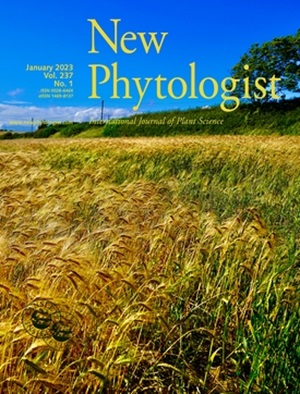A transcription factor SlWRKY71 activated the H2S generating enzyme SlDCD1 enhancing the response to Pseudomonas syringae pv DC3000 in tomato leaves
IF 8.3
1区 生物学
Q1 PLANT SCIENCES
引用次数: 0
Abstract
- H2S is a well-known gaseous signaling molecule that plays important roles in plant response to biotic stresses. Pseudomonas syringae pv tomato (Pst) could cause enormous loss, while whether H2S could modulate plant defense against Pst is still unclear.
- By CRISPR/Cas9, the Sldcd1 gene editing mutant showed reduced endogenous H2S content and attenuated resistance, whereas treatment with exogenous H2S could enhance the resistance. A transcription factor, SlWRKY71, was screened and identified to promote the transcription of SlDCD1 via yeast one-hybrid, dual-luciferase reporter system, electrophoretic mobility shift assays, and transient overexpression.
- Here, it was found that exogenous H2S relieved the symptoms of bacterial speck disease in tomato leaves, conferring tolerance to Pst. DC3000, and the expression of the H2S-producing enzyme SlDCD1 was significantly induced. The Slwrky71 mutant also showed reduced defense in tomato leaves against Pst. DC3000, whereas SlWRKY71-OE tomato leaves showed increased tolerance. Transient overexpression of SlDCD1 in the context of Slwrky71 with exogenous H2S treatment has stronger resistance, and the overexpression of SlWRKY71 in the context of Sldcd1 showed relatively weak disease resistance, and with the addition of H2S enhanced the effect.
- Therefore, we concluded that SlWRKY71 could activate SlDCD1 expression and promote endogenous H2S production, thereby improving tomato leaves resistance to Pst. DC3000.
求助全文
约1分钟内获得全文
求助全文
来源期刊

New Phytologist
生物-植物科学
自引率
5.30%
发文量
728
期刊介绍:
New Phytologist is an international electronic journal published 24 times a year. It is owned by the New Phytologist Foundation, a non-profit-making charitable organization dedicated to promoting plant science. The journal publishes excellent, novel, rigorous, and timely research and scholarship in plant science and its applications. The articles cover topics in five sections: Physiology & Development, Environment, Interaction, Evolution, and Transformative Plant Biotechnology. These sections encompass intracellular processes, global environmental change, and encourage cross-disciplinary approaches. The journal recognizes the use of techniques from molecular and cell biology, functional genomics, modeling, and system-based approaches in plant science. Abstracting and Indexing Information for New Phytologist includes Academic Search, AgBiotech News & Information, Agroforestry Abstracts, Biochemistry & Biophysics Citation Index, Botanical Pesticides, CAB Abstracts®, Environment Index, Global Health, and Plant Breeding Abstracts, and others.
 求助内容:
求助内容: 应助结果提醒方式:
应助结果提醒方式:


